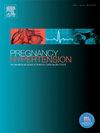在当代肥胖人群中,门诊监测无严重特征的子痫前期是否仍然安全?
IF 2.9
4区 医学
Q2 OBSTETRICS & GYNECOLOGY
Pregnancy Hypertension-An International Journal of Womens Cardiovascular Health
Pub Date : 2025-05-21
DOI:10.1016/j.preghy.2025.101225
引用次数: 0
摘要
目的几十年前,当肥胖率较低时,对子痫前期妊娠的门诊监测进行了研究。在当代肥胖人群中,先兆子痫的发生率和总体发病率更高。我们试图回顾当代肥胖人群中无严重特征的先兆子痫的门诊管理的安全性。研究设计:机构回顾性队列研究,分析2010年1月1日至2020年12月31日183例诊断为无严重特征的先兆子痫患者的结局。主要观察指标:从诊断到分娩的潜伏期(以天为单位)。结果平均BMI为35.4 (SD 8.2),住院组与门诊组BMI差异无统计学意义(34.5 vs 36.5, p = 0.12)。门诊组的潜伏期明显更长(20.4天vs 11.8天,p <;0.01)。调整后,住院组和门诊组的潜伏期差异仍然具有统计学意义(平均差异为- 7.0,95% CI为- 11.3至- 2.7)。此外,门诊组分娩时胎龄较高(35.7 vs 34.2, p <;0.01),总住院天数更少(8.3 vs 12.1天,p <;0.01), 34周龄前早产发生率较低(18% vs 39%, p <;0.01)。新生儿结局分析发现门诊组的出生体重更高(2544.8 g vs 2187.6 g, p <;0.01),新生儿重症监护病房的总天数更少(24.9 vs 41.8天,p <;0.01)。结论门诊管理已成为治疗无严重特征先兆子痫的预期做法。我们的研究结果在现代肥胖人群中支持这种管理策略。本文章由计算机程序翻译,如有差异,请以英文原文为准。
Is outpatient surveillance of preeclampsia without severe features still safe in contemporary obese Populations?
Objective
Outpatient surveillance of preeclamptic pregnancies was studied several decades ago when rates of obesity were lower. The rate of preeclampsia and overall morbidity are higher in contemporary obese cohorts. We sought to review the safety of outpatient management of preeclampsia without severe features in a contemporary obese population.
Study design
Institutional retrospective cohort study analyzing the outcomes of 183 patients diagnosed with preeclampsia without severe features from 1/1/2010 to 12/31/2020.
Main outcome measures
Latency in days between diagnosis and time of delivery.
Results
The average BMI was 35.4 (SD 8.2), and the inpatient and outpatient groups did not have differences in BMI (34.5 vs 36.5, p = 0.12). The outpatient group was found to have significantly longer latency (20.4 vs 11.8 days, p < 0.01). After adjustment, differences in latency for the inpatient and outpatient group remained statistically significant (Mean Difference −7.0, 95 % CI −11.3 to −2.7). Additionally, the outpatient group had a higher gestational age at delivery (35.7 vs 34.2, p < 0.01), fewer total hospital days (8.3 vs 12.1 days, p < 0.01), and fewer occurrences of preterm delivery before 34 weeks gestational age (18 % vs 39 %, p < 0.01). Analysis of neonatal outcomes found the outpatient group had greater birth weights (2544.8 vs 2187.6 g, p < 0.01) and fewer total days in the NICU (24.9 vs 41.8 days, p < 0.01).
Conclusion
Outpatient management has become the expected practice when managing preeclampsia without severe features. Our study’s findings support this management strategy in the modern obese population.
求助全文
通过发布文献求助,成功后即可免费获取论文全文。
去求助
来源期刊

Pregnancy Hypertension-An International Journal of Womens Cardiovascular Health
OBSTETRICS & GYNECOLOGYPERIPHERAL VASCULAR-PERIPHERAL VASCULAR DISEASE
CiteScore
4.90
自引率
0.00%
发文量
127
期刊介绍:
Pregnancy Hypertension: An International Journal of Women''s Cardiovascular Health aims to stimulate research in the field of hypertension in pregnancy, disseminate the useful results of such research, and advance education in the field.
We publish articles pertaining to human and animal blood pressure during gestation, hypertension during gestation including physiology of circulatory control, pathophysiology, methodology, therapy or any other material relevant to the relationship between elevated blood pressure and pregnancy. The subtitle reflects the wider aspects of studying hypertension in pregnancy thus we also publish articles on in utero programming, nutrition, long term effects of hypertension in pregnancy on cardiovascular health and other research that helps our understanding of the etiology or consequences of hypertension in pregnancy. Case reports are not published unless of exceptional/outstanding importance to the field.
 求助内容:
求助内容: 应助结果提醒方式:
应助结果提醒方式:


